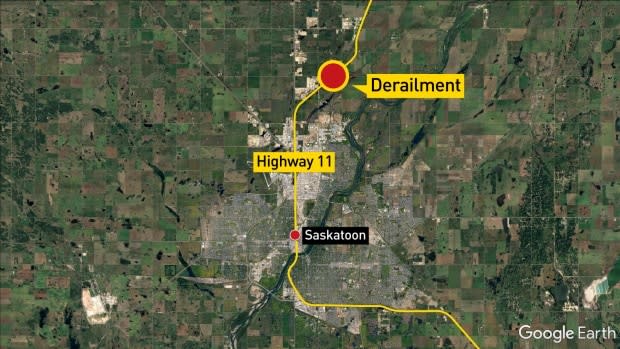Broken rail caused 2019 train derailment outside Saskatoon, report finds

Over a year after a grain-hauling train derailed and crashed in flames outside Saskatoon, the Transportation Safety Board of Canada says the accident was caused by a broken rail on the track.
According to a TSB report released Thursday, the CN train was travelling south through the Warman subdivision on the morning of Jan. 22, 2019, when it passed over a part of track where the upper part of the rail was missing. Investigators believe it had been broken off by an earlier train.
When the rest of the rail failed under the 27th rail car, the train derailed, crashed and caught fire.
Eyewitnesses reported seeing cars appear to jump and skip off the tracks and hearing a booming, pulsating noise.
No one was injured, and the report found the actions of the train crew were not a contributing factor in the derailment.
The broken rail that caused the crash was included in a rail flaw inspection of the area that occurred less than a month before the accident, but the inspection did not identify any problems at that time, the report says.
Track safety rules require tracks like those in the Warman subdivision, which exceed certain tonnage requirements, to be inspected twice a year. In this case, the track had not been inspected in the second half of 2017 or the first half of 2018.
"Had the additional track inspections been undertaken as the [track safety rules] require, the track in the vicinity of the Highway 11 crossing could potentially have been identified as a location with significant track deterioration, requiring further track surface maintenance," the report found.
Investigators believe the rail head in question had developed an internal fracture that went undetected as it grew, weakening the structure until it broke.
"Although the rail (manufactured in 1953) in the joint had been present in the track for only two months … it could not resist the development of a bolt hole crack and its quick propagation to the rail head," investigators wrote in the report.

The TSB report also draws attention to the risk of installing older rail components, which are more likely to fracture than newer materials, in areas of track known to bend under heavy wheel loads.
"If rail manufactured with lower fracture toughness is installed" in those areas, the report says, "there is a risk that rail defects will develop and progress to failure faster than the rail flaw inspection regime can detect them."
Currently, the TSB is continuing its investigations into the two train derailments that occurred near Guernsey, Sask., in late 2019 and early 2020.


